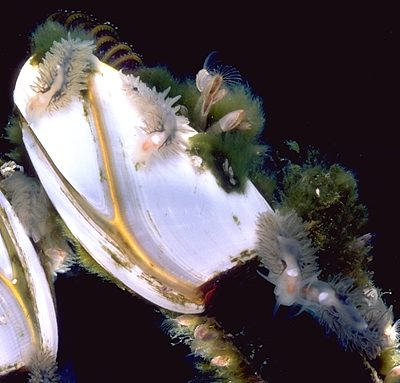
Fiona pinnata
(Eschscholtz, 1831)
Order: NUDIBRANCHIA
Suborder: AEOLIDINA
Family: Fionidae
DISTRIBUTION
Worldwide distribution on floating objects
PHOTO
Eden, southern New South Wales, Australia. February 1983, AM C137996. On Lepas sp attached to driftwood. Inset showing undulating 'gill' along cerata. Note white anal papillae midway down body in lower photos. PHOTOS: Bill Rudman.
The family is based on this single species. It grows to about 20mm long and lives exclusively on floating objects in the sea, usually feeding on goose barnacles (Lepas spp.) but it has been reported by M.C.Miller to feed on floating cnidarians such as Physalia and Velella. The rhinophores are smooth and the cerata are arranged irregularly along eacg side of the body without any clear clustering or obvious sytem of rows. The cerata lack cnidosacs and are unique in having an undulating 'fin' or 'gill' along the postero-dorsal edge. The anus opens dorsally on the right side, about midway down the body just inside the cerata. Although often described as pelagic, Fiona is unable to swim, and from metamorphosis, lives on floating objects. It usually metamorphoses on goose barnacles. Large populations and their egg masses can often be found associated with colonies of goose barnacles on driftwood, fishing floats. They can also be found on small objects such as Sepia 'cuttlebones' and even Spirula shells - anything on which goose barnacles can live.
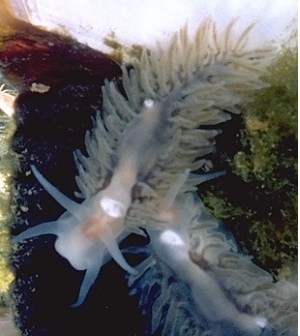
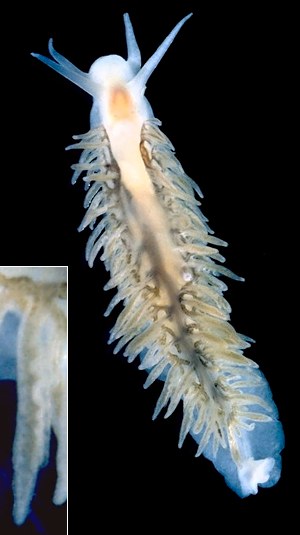
Rudman, W.B., 2002 (June 18) Fiona pinnata (Eschscholtz, 1831). [In] Sea Slug Forum. Australian Museum, Sydney. Available from http://www.seaslugforum.net/find/fionpinn
Related messages
Fiona pinnata from Sth Africa
July 21, 2007
From: Colin Ogden
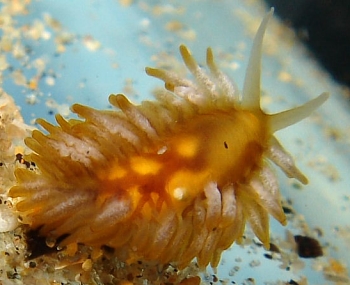
Hi Bill,
Thanks so much for the many responses recently, and also for the copy of the paper on the feeding on sponges. Recently one of my skippers, Eben Louw, picked up a piece of plastic floating out on the ocean and found this little creature attached to the plastic. He kept the little fellow to show me. I think it is the same creature that you have on the forum as either a Cuthona or a Eubranchus.
I notice that there has been no correspondence on this so I thought I would send in a message.
Locality: Sodwana Bay, surface, South Africa, Indian, 30 March 2007, open ocean inside bay. Length: 4mm. Photographer: Colin Ogden.
This find probably won't add anything to our knowledge of this nudibranch, even distribution might not be of value, because the plastic might have come from anywhere.
regards
Colin
scubaco@iafrica.com
Ogden C. M., 2007 (Jul 21) Fiona pinnata from Sth Africa. [Message in] Sea Slug Forum. Australian Museum, Sydney. Available from http://www.seaslugforum.net/find/20258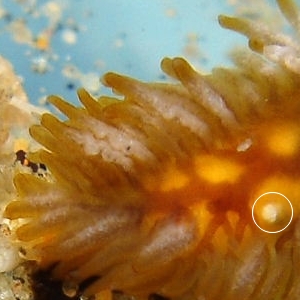
Dear Colin,
I am not sure which animal you are referring to. It's a good idea if you are referring to a Forum message to use it number [this one is #20258] which you can find on the url address of the message or from the citation footnote on each page.
Your animal is quite interesting. It is Fiona pinnata which spends its life on floating objects in the ocean - floats, wood, plastic etc - and feeds on goose barnacles. Have a look at the Fact Sheet. One characteristic feature is the white wrinkled blade along the upper edge of each ceras which you can see in the close-up alongside. Another is the position of the anus above the cerata about halfway down the right side [see white ring]. I am not sure what the purpose of the wrinked blade on the cerata is. The other thing you can see in your photos is the dark brown branching pattern on the body. That is the branching of the digestive gland ducts, which connect the digestive gland in each ceras, to the stomach.
Best wishes,
Bill Rudman
Re: What kind of animal is this?
August 19, 2006
From: Patrizia Schiozzi
Concerning message #17515:
Dear Bill,
I've been searching with Google and they are indeed goose barnacles, so please accept my apology for having been a bit sceptical! And indeed, thank you very much for your interesting explanation.
I have several pictures of the goose barnacles. All the pictures are of good quality (suitable for print), so if you ever need one, let me know.
Best regards,
Patrizia Schiozzi
Dordrecht, NL
patrizia@xs4all.nl
P.G. Schiozzi, 2006 (Aug 19) Re: What kind of animal is this?. [Message in] Sea Slug Forum. Australian Museum, Sydney. Available from http://www.seaslugforum.net/find/17524Re: What kind of animal is this?
August 19, 2006
From: Patrizia Schiozzi
Concerning message #17489:
You could be right, but then something very strange must have happened. In fact there were thousands of these animals on the beach. The 'spongy' thing in the middle was exactly the same in all the animals. It looked a bit like a kind of 'placenta' (I know this must sound nonsense...) where all the shellanimals were connected to.
Do you know another forum where I could ask my question?
Kind regards,
Patrizia
patrizia@xs4all.nl
Schiozzi, P.G., 2006 (Aug 19) Re: What kind of animal is this?. [Message in] Sea Slug Forum. Australian Museum, Sydney. Available from http://www.seaslugforum.net/find/17515Dear Patrizia,
Firstly you are right not to believe everything you find on the world wide web, but the Sea Slug Forum is a publication of the Australian Museum, so I hope it is credible. If you want to check my credibility, my advice would be for you to use a search engine like Google and search for goose barnacle. I just did and got lots of pictures which match your animals, which suggests I could be right. Or you could always go to a library and look in a reference book. I am afraid there are very few forums like the Sea Slug Forum and I certainly don't know one on crustaceans ... and even if there were, you would still have the dilemma of having to decide which forum you are going to believe.
This is one of the problems of the web - it certainly makes information more available, but it also makes misinformation just as easily available. I guess the greatest absurdity is the online encyclopedia Wikipedia which allows anyone to edit entries. This seems to be taking us back to the Dark Ages where geese were supposed to develop from goose barnacles - because that's what people told each other! The medieval village square and Wikipedia have much in common.
The identity of the white bit in the middle of your photo is really immaterial, as goose barnacles attach to any floating object, including ship's hulls. Sometimes you will find large areas of water covered in small floating blocks of volcanic pumice, all with goose barnacles attached. I once came across thousands of apples washed up on a beach - apparently washed off a ship during a storm - and they were also covered in goose barnacles. The apples were quite edible after I pulled off the barnacles.
I have no idea what the white things are, but for some reason they were all floating together in the sea. They obviously crossed paths with a 'swarm' of free-swimming goose barnacle larvae, which settled on the white things and grew to the size you found them. Unfortunately for the barnacles, a storm has stranded the 'white things', and their cargo, on the shore.
Best wishes,
Bill Rudman
What kind of animal is this?
August 18, 2006
From: Patrizia Schiozzi
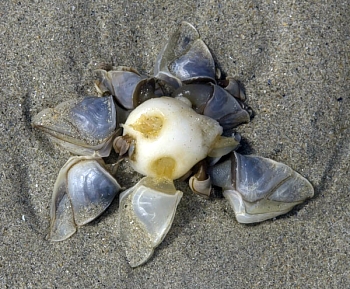
Can someone tell me what kind of animal is this? I saw it during a beachwalk in Ireland a couple of weeks ago. Locals were quite puzzled: they hadn't seen such an animal ever before! Could the warm weather have brought these animals far from their normal habitat?
Locality: Carrickduff beach, Carrickglass beach, Cuminola beach, Co Clare, Co Kerry, Ireland, Atlantic ocean, 2 augustus 2006. Length: about 15 cm. Photographer: Patrizia Schiozzi.
Patrizia Schiozzi
patrizia@xs4all.nl
Schiozzi, P.G., 2006 (Aug 18) What kind of animal is this?. [Message in] Sea Slug Forum. Australian Museum, Sydney. Available from http://www.seaslugforum.net/find/17489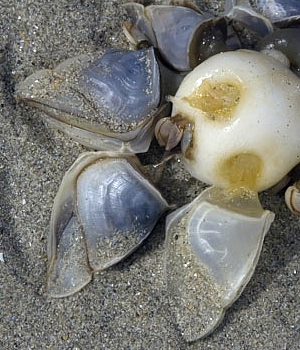
Dear Patrizia,
Normally I try and avoid answering questions on things that are clearly not a sea slugs, simply because I don't have time for all the sea slug queries, but since your object is the food of a sea slug, I will be kind.
The white object in the middle could be a bird skull, but what ever it is, it is just a floating object for the other objects to attach to. Eac of them is a separate animal, a barnacle, attached by its leathery stalk to the white floating object. From the different sizes of barnacle you can see in the photo, larvae have settled on the float a number of times. Barnacles are very specialised crustacea [crab, prawns, lobsters etc], and this stalked group are often called Goose Barnacles becasue of their resemblance to the head and neck of a goose. In fact in medieval times they were said to turn into geese - though I can't quite see how medieval people would have missed the point of eggs.
If you look at the Fact Sheet for the nudibranch Fiona pinnata, you will see photos of live goose barnacles, which are its preferred food.
Best wishes,
Bill Rudman
Fiona pinnata in northern Canada
August 9, 2003
From: Andy Lamb
Hello Bill,
This is just a quick note and I do hope to participate more fully in the future.
On a recent trip to the Queen Charlotte Islands in northern British Columbia, Canada, I found a drifting bull kelp plant colonized by Lepas barnacles and populated by very large egg-laying Fiona pinnata. Behrens reported it to be a tropical species with a worldwide distribution and responses in the Forum seem to bear that out for the most part. Is my sigting this far north unusual?
Regards,
Andy Lamb
Vancouver Aquarium Marine Science Centre
lamba@vanaqua.org
Lamb, A, 2003 (Aug 9) Fiona pinnata in northern Canada. [Message in] Sea Slug Forum. Australian Museum, Sydney. Available from http://www.seaslugforum.net/find/10663Dear Andy,
Fiona pinnata is a truly cosmopolitan species, apparently dependent only on floating objects to drift on, and Lepas, or related barnacles, to feed on. In fact it was first described from specimens found at Sitka, Alaska. It is known from all the major oceans of the world, from Alaska in the north to at least New Zealand and South Africa in the south.
Best wishes,
Bill Rudman
Fiona pinnata from Lord Howe Island
January 25, 2003
From: W.B. Rudman

Here is a photo record from Ian Hutton of Fiona pinnata from Lord Howe Island.
Location: Lagoon Beach.
These photos show the characteristic wrinkled plate plate - sometimes described as a gill - along the edge of each ceras very clearly.
Bill Rudman
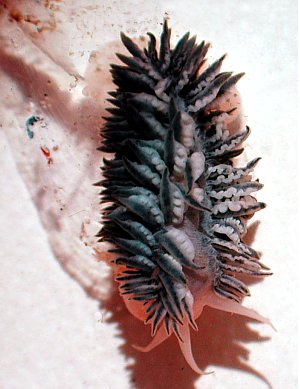
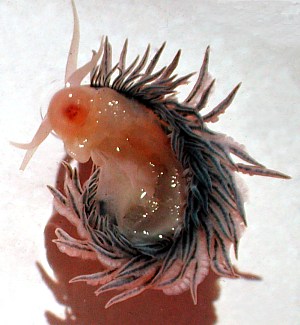
Two types of Fiona pinnata from Hachijo Island Japan
June 21, 2002
From: Shouichi Kato

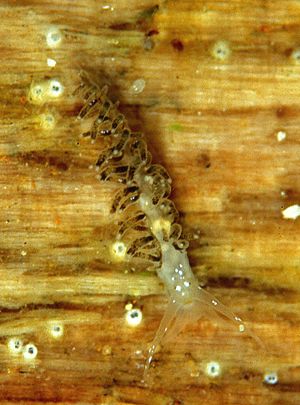
Dear Bill,
A member of my staff, S. Harazaki, picked up an interesting driftwood, in May. There were dozens of Fiona pinnata and we tried separate them to two types.
One type (LOWER PHOTO), is typical one, with white body and light brown rhinophore, around 10mm in size.
Another type (UPPER PHOTO) is larger, 20mm - 30mm in size, has brown body, release a lot of eggs on the driftwood.
I'm interested in knowing if two types of Fiona pinnata can be found on one driftwood.
Best regards,
S.Kato
regulus@edit.ne.jp
Kato, S., 2002 (Jun 21) Two types of Fiona pinnata from Hachijo Island Japan. [Message in] Sea Slug Forum. Australian Museum, Sydney. Available from http://www.seaslugforum.net/find/7269Dear Shouichi,
This is an interesting observation. I don't recall seeing the darkly pigmented form of Fiona before. I think we would need to have a closer look at the animal to see just what you have here.
Best wishes,
Bill Rudman
Fiona pinnata from Korea
June 21, 2002
From: Dongbum Koh
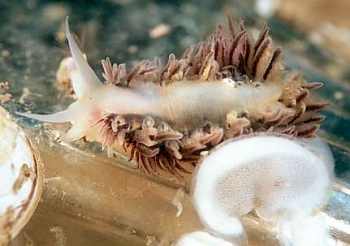
Dear Bill
I took this picture in Mun islet, Cheji Is. in May 2000, 20m depth. It attached its eggs (discoid white capsule) on the surface of this glass bottle. I can`t find this seaslug in the books. I think its very rare because it is the 1st time I have found it during about 1000 times diving in the Cheju area, S. Korea.
Could you help me identify it please?
Best regards.
Dongbum, Koh
drkoh@seasee.co.kr
Koh, D.B., 2002 (Jun 21) Fiona pinnata from Korea. [Message in] Sea Slug Forum. Australian Museum, Sydney. Available from http://www.seaslugforum.net/find/7284Dear Dongbum,
This is Fiona pinnata. It is not surprising that you have not seen it before, because it lives on floating objects, such as driftwood, fisherman's floats etc, and feeds on stalked barnacles, such as Lepas. I once found thousands on a large (10-15m long) log washed up on a deserted beach. The log was covered in stalked barnacles, Fiona and its eggs - not much wood visible at all. My camera, as always, was a 5 kilometre walk down the beach with the tide coming in. So I never did photograph that find.
This species is found worldwide - but usually on driftwood on sandy beaches - which are not the usual place for divers to look for nudibranchs.
Best wishes,
Bill Rudman
Fiona pinnata from New South Wales, Australia
June 21, 2002
From: Bill Rudman

Hare are some photos of Fiona pinnata from eastern Australia to accompany today's messages from Japan and Korea.
• Eden, southern New South Wales, Australia. February 1983, AM C137996. On Lepas sp attached to driftwood. Inset showing undulating 'gill' along cerata. Note white anal papillae midway down body in lower photos. PHOTOS: Bill Rudman.
Best wishes,
Bill Rudman


